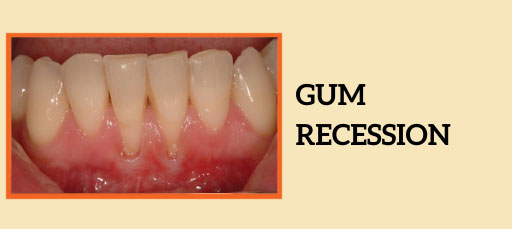
Gum Recession – Symptoms, Causes, Treatment
Table of Contents
Your smile is one of your most expressive features, but when a recession of gums occurs, it can affect not only your appearance but also your dental health.
What is Gum Recession?
Gum recession also known as Gingival recession is a condition where the margin of the gum tissue surrounding the teeth wears away or pulls back, exposing more of the tooth or its root. This can lead to gaps or pockets forming between the teeth and gums, making it easier for bacteria to build up.
It often causes tooth sensitivity to hot or cold temperatures and can eventually lead to tooth decay or even tooth loss if left untreated. Factors such as genetics, aggressive tooth brushing, gum disease, hormonal changes, and poor dental hygiene can contribute to gum recession.
Symptoms of Gum Recession
- Visible Tooth Roots: One of the primary signs is the exposure of tooth roots as the gum line recedes.
- Sensitive Teeth: Increased sensitivity to hot or cold temperatures in the affected teeth.
- Bleeding Gums: Gums might bleed during brushing or flossing.
- Longer Teeth: Teeth may appear longer than usual due to the recession of the gums.
- Loose Teeth: In severe cases, teeth might feel loose or become misaligned.
Causes of Gum Recession
Several factors contribute to gum recession:
- Poor Oral Hygiene: Inadequate brushing and flossing can lead to the accumulation of plaque, causing gum disease.
- Gum Disease (Periodontitis): Bacterial infections can damage gum tissues and lead to recession.
- Genetics: Some individuals might be genetically predisposed to thinner or weaker gum tissues.
- Bruxism (Teeth Grinding): Constant grinding can wear down gums.
- Tobacco Use: Smoking or using tobacco products can increase the risk of gum recession.
- Hormonal Changes: Hormonal fluctuations in women can make gums more sensitive and prone to recession.
Gum Recession Treatment Options
The treatment for gum recession depends on its severity:
- Improved Oral Hygiene: Maintaining proper dental care, including regular brushing and flossing, can prevent further recession.
- Scaling and Root Planing: Deep cleaning by a dentist to remove plaque and tartar buildup.
- Gum Grafting: In severe cases, tissue grafts from other areas of the mouth can cover exposed roots.
- Pinhole Surgical Technique (PST): A minimally invasive procedure using small holes to reposition gum tissue.
- Lifestyle Changes: Quitting smoking and managing teeth grinding can help prevent further recession.
Prevention
Preventing gum recession involves consistent oral care:
- Brushing: Use a soft-bristled toothbrush and gentle brushing techniques.
- Flossing: Regular flossing removes plaque between teeth and along the gumline.
- Regular Dental Visits: Routine check-ups and cleanings are essential for early detection and treatment.
Conclusion
Gum recession is a concerning dental issue that requires attention to prevent further complications. By maintaining good oral hygiene practices, seeking professional dental care, and making necessary lifestyle changes, you can effectively prevent and treat gum recession, preserving both your smile and overall dental health.
Remember, early detection and prompt action are crucial in addressing gum recession. Consult with your dentist if you notice any signs or symptoms to ensure timely intervention and the preservation of your dental well-being.
Leave a Reply
Leave a Reply
Explore More Similar Posts
Explore More Blogs


Leave a Reply